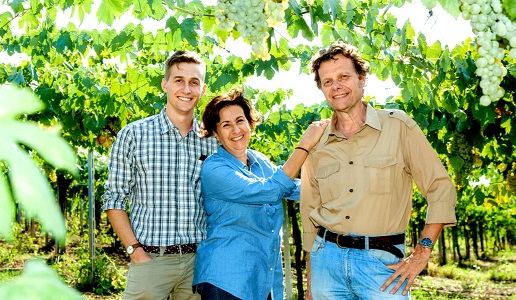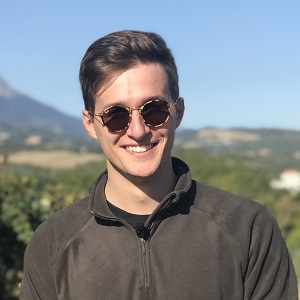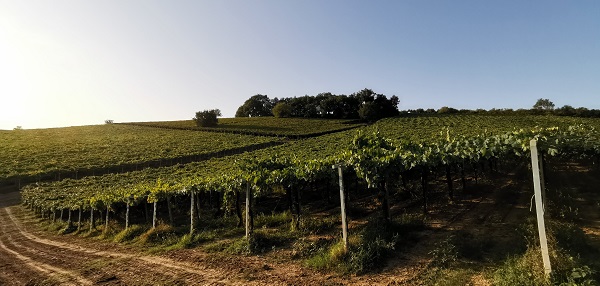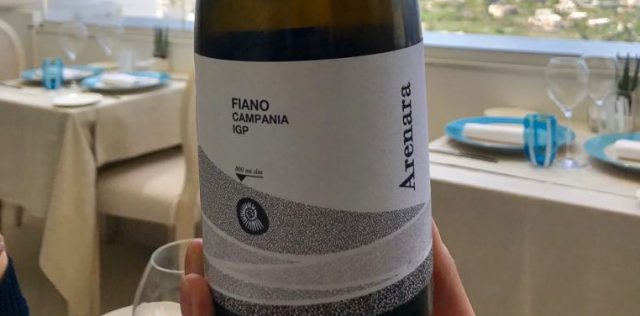An interview with the young Gabriele Valentini

After earning his degree in economics, 26-year-old Gabriele Valentini now works with his father Francesco Paolo at their estate, having also observed his grandfather there as a child.
Gabriele Valentini, like his grandfather Edoardo and father Francesco Paolo, does not like to be the center of attention, preferring to have their three versions of Montepulciano, Trebbiano and Cerasuolo wine take center stage. The 70 hectares of vineyards they have, out of the 250 hectares they own, produce 32,000 bottles a year. One must wait to truly appreciate these wines and if you are in a hurry, then try something else because their propensity to age is one of their main traits. Neither visits nor on-site sales are possible at their home-winery in Loreto Apruntino, in an old noble palace.
Gabriele is 26 years old and after earning a degree in economics, at Pescara University, he entered the family business where Francesco Paolo, who he looks a lot like, is his mentor. Their production method has always been a high and rigorous example of craftsmanship and so there was no need for him to study agriculture nor winemaking since the practices followed by Valentini go in the opposite direction of standardization. They already have everything they need to honor family roots and traditions.
DoctorWine: The passing of the reins from your grandfather to your father resulted in a significant change even if this was in absolute respect of the estate’s style. What do you think will change when you will be in charge?
Gabriele Valentini: Although there have been changes and there will be changes, the style and the approach to problems will always remain the same. Changes will be determined by the need to adapt to the environment, climate and market because we have no desire to make changes just to produce something different. I am my father’s humble pupil, I accept his views, his know-how, and on these will draw my own conclusions. I began working at the winery seven years ago, he has 40 years of experience behind him, thus I am still an apprentice.
DW: Is this a career you have chosen or was it imposed?

GV; Neither of the two. As a child I used to play inside the barrels, most of the work was done at home and this was the reality I grew up with it.
DW: Is being a Valentini as responsibility?
GV: The estate has been around for centuries, dating back to 1650, while the modern age, bottling and selling wine, is 70-80 years old. I have great respect for the past and some trepidation about the future but the situation is not that dramatic.
DW: What is the Valentini style?
GV: I myself cannot define the style, I would be making it up, but I can tell you how we interpret our concept of craftsmanship. The focus is on the prime ingredient, quality derives from the selection made in the vineyard and the health of the grapes. We try to bring out the best from the harvest and if it does not meet the criteria we strive for, then we risk skipping a year’s production or losing some of the harvest.
We use very few chemicals, we do not add, we do not correct, the best goes into the bottle, the rest is bulk wine.
DW: What do you think of natural and biodynamic wines?
GV: There are no absolute truths, there are values one can share or not. It is not important to classify the way a wine is made in its certification. There is no need for regulations that risk tangling you up and while one can start off with the best intentions they can end up being exploited to meet the demands of marketing and sales. The idea behind these two schools of thought is authentic, the intentions are the best, one should not generalize.
DW: How important is dialogue and the exchange of ideas between winemakers?
GV: The identity of Abruzzo wines was made possible thanks to the contribution of people like my grandfather, Gianni Masciarelli, Emidio Pepe and many others. They all played a role in getting it known worldwide. Dialogue and exchanging ideas are necessary, both from a commercial and technical point of view. One should not be so presumptuous to think they know everything. Climate change in agriculture, for example, has as not been uniform, we have seen new problems and discovered unknown insects. For me, producers in neighboring towns should create a network, be friends and not rivals. There us a lot of unity among us.
DW: What direction is Abruzzo wine taking?

GV: Abruzzo is a region suited for winemaking with its unique microclimate, vicinity to the mountains, sharp temperature variations and morphological variety. The shortcomings in regional production are rooted in the antiquated mentality of the 1950s to produce quantity over quality. The consumer remains confused by the vast difference in prices in the same area. The new generation of producers is slowing abandoning the old ways and focusing more on enhancing the value of native varietals and reducing yield.
DW: Tell me about the new oil mill you recently opened.
GV: The oil mill was a return to our roots. We opened it in Loreto in a joint venture with the Cerretani family. My ancestors were oil pressers and in the 19th century exported oil abroad. At the time it was an unusual activity and our setup was the largest in the area. Oil production methods have changed, technology is essential, the more efficient the extractor the better the oil is and it is for this reason that we have relied on authentic experts. We use two varieties of olives, in particular: Dritta and Leccino.
DW: You have information on climate change since 1818, especially in regard to Trebbiano. At what point is your research?
GV: From the start the focus has been on working and family life. From local documents and working in cooperation with the University of Bologna we have pinpointed the start of every harvest in order to draw a parallel with industrialization. What we have discovered is that the dates harvest began have progressively come earlier as a consequence of global warming and higher temperatures. We are currently advancing the studies working with Professor Piero Di Carlo, who teaches physics and meteorology at the University of Chieti. It began as simple curiosity and has now progressed into becoming a key to understanding the evolution and repercussions that weather has on man and the environment.

 Italiano
Italiano








